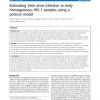Free Online Productivity Tools
i2Speak
i2Symbol
i2OCR
iTex2Img
iWeb2Print
iWeb2Shot
i2Type
iPdf2Split
iPdf2Merge
i2Bopomofo
i2Arabic
i2Style
i2Image
i2PDF
iLatex2Rtf
Sci2ools
106
Voted
BMCBI
2010
2010
Estimating time since infection in early homogeneous HIV-1 samples using a poisson model
Background: The occurrence of a genetic bottleneck in HIV sexual or mother-to-infant transmission has been well documented. This results in a majority of new infections being homogeneous, i.e., initiated by a single genetic strain. Early after infection, prior to the onset of the host immune response, the viral population grows exponentially. In this simple setting, an approach for estimating evolutionary and demographic parameters based on comparison of diversity measures is a feasible alternative to the existing Bayesian methods (e.g., BEAST), which are instead based on the simulation of genealogies. Results: We have devised a web tool that analyzes genetic diversity in acutely infected HIV-1 patients by comparing it to a model of neutral growth. More specifically, we consider a homogeneous infection (i.e., initiated by a unique genetic strain) prior to the onset of host-induced selection, where we can assume a random accumulation of mutations. Previously, we have shown that such a ...
| Added | 09 Dec 2010 |
| Updated | 09 Dec 2010 |
| Type | Journal |
| Year | 2010 |
| Where | BMCBI |
| Authors | Elena E. Giorgi, Bob Funkhouser, Gayathri Athreya, Alan S. Perelson, Bette T. Korber, Tanmoy Bhattacharya |
Comments (0)

